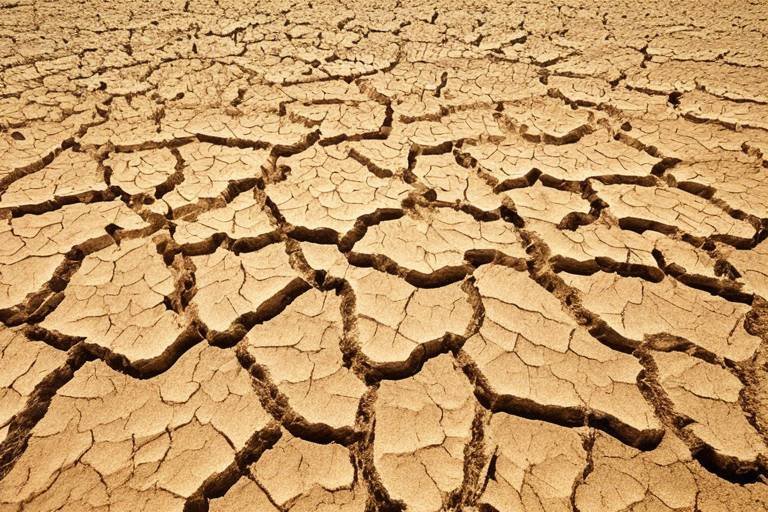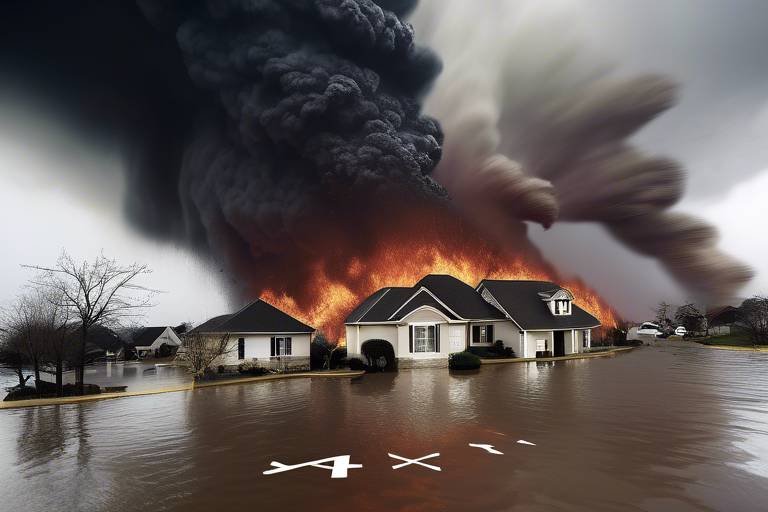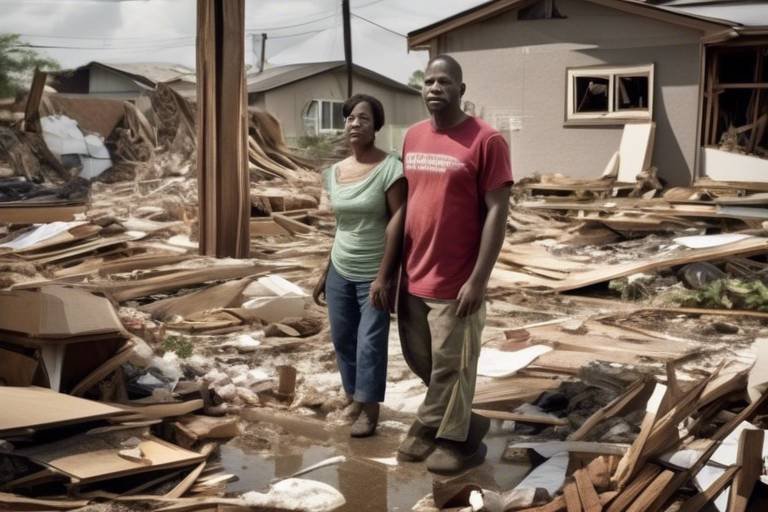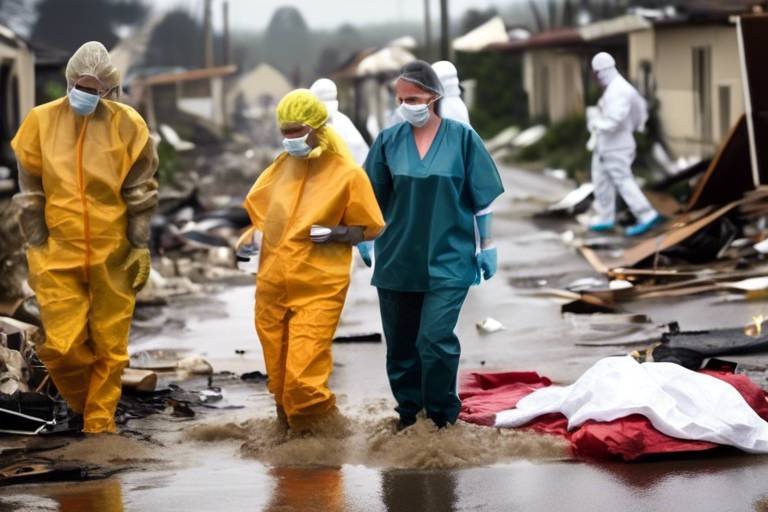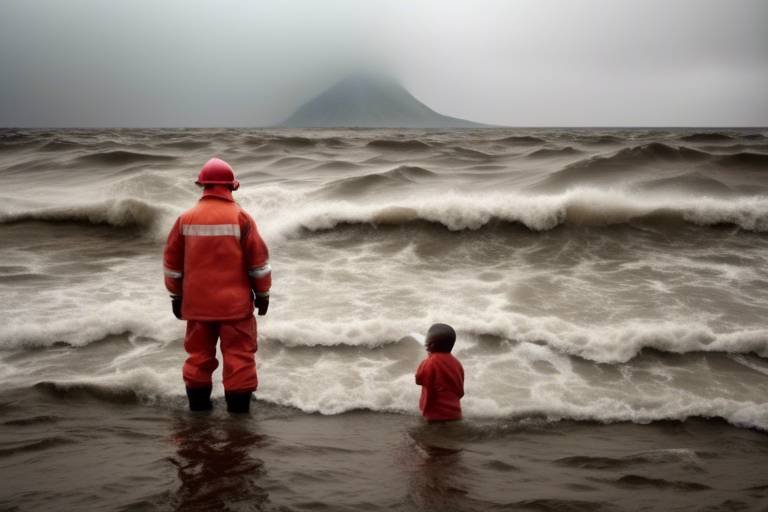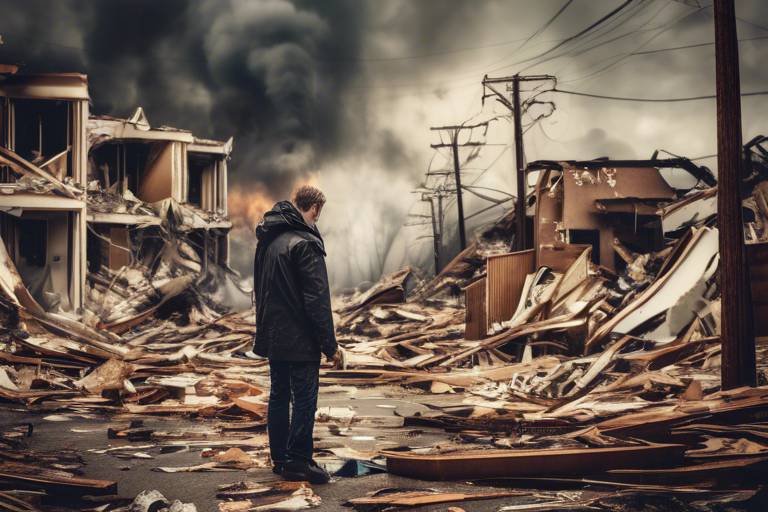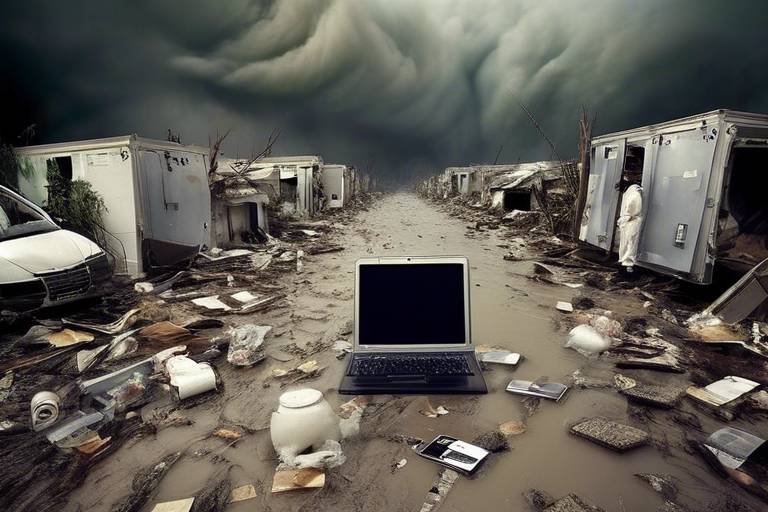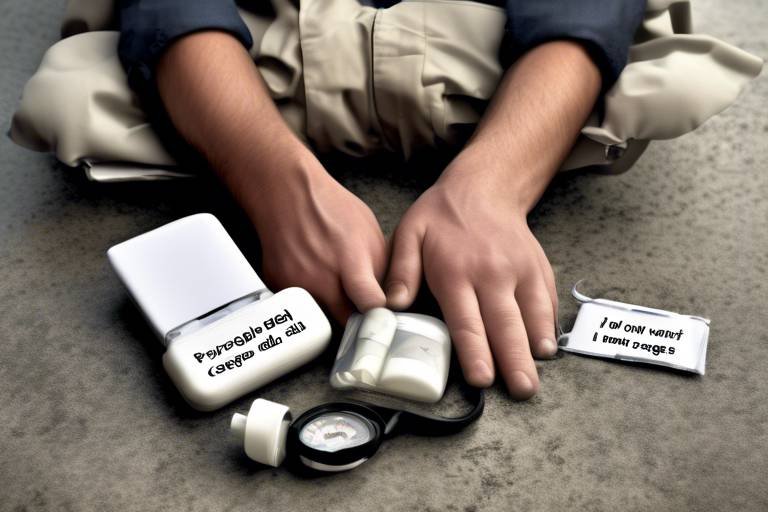Dealing with Heat Waves and Droughts - Essential Preparedness Tips
This article provides crucial information on how to effectively prepare for and cope with heat waves and droughts, ensuring safety and resilience during extreme weather conditions. As the climate changes, we find ourselves facing more frequent and intense weather events. Heat waves and droughts are no longer just seasonal nuisances; they can be life-threatening challenges that affect our health, environment, and daily lives. Understanding how to navigate these extremes can make all the difference. So, let’s dive into the essentials of preparing for these weather phenomena, ensuring you and your loved ones remain safe and healthy.
Heat waves pose significant health risks. But what exactly is a heat wave? It’s not just a few hot days; it’s a prolonged period of excessively hot weather, often accompanied by high humidity. These conditions can lead to serious health issues, particularly for vulnerable populations like the elderly, children, and those with pre-existing health conditions. The causes of heat waves are multifaceted, including climate change, urbanization, and natural weather patterns. As these heat waves become more common, we must understand their implications on our communities. Awareness and preparedness are paramount. Knowing when a heat wave is forecasted can be the first step in protecting yourself and your family.
Droughts can lead to severe water shortages that impact agriculture, drinking water supplies, and ecosystems. Recognizing the signs of drought is crucial for timely action. You might notice that your local rivers and lakes are receding, or perhaps your garden isn't thriving as it usually does. Droughts can be insidious, creeping up on communities without much warning. They can lead to devastating environmental impacts, such as soil degradation and loss of biodiversity. Early warning signs include reduced rainfall, increased temperatures, and prolonged dry spells. Being vigilant about these changes can help you take appropriate action before the situation worsens.
Heat-related illnesses can be life-threatening, and it’s essential to recognize them early. Common health risks include heat exhaustion and heat stroke. Heat exhaustion often manifests as heavy sweating, weakness, and dizziness. If not addressed, it can escalate to heat stroke, which is characterized by a high body temperature, confusion, and even loss of consciousness. To prevent these conditions, it’s vital to stay informed and take proactive measures. Make sure to check on friends and family, especially those who are elderly or have health issues. Stay indoors during peak heat hours and wear light clothing. Remember, a little awareness can go a long way in preventing serious health issues.
Staying hydrated is crucial during heat waves. But how much water do you really need? The general recommendation is to drink at least 8-10 glasses of water a day, but this can vary based on your activity level and environmental conditions. During extreme heat, you might need even more! It’s not just about drinking water; consider incorporating hydrating foods into your diet, such as cucumbers, watermelon, and oranges. Avoid caffeinated and alcoholic beverages, as they can lead to dehydration. Keep a water bottle handy and make it a habit to sip throughout the day. Remember, staying hydrated is your first line of defense against heat-related illnesses!
Recognizing the symptoms of heat-related illnesses can save lives. Be on the lookout for signs such as confusion, nausea, headaches, and rapid heartbeat. If you or someone else exhibits these symptoms, it’s crucial to act quickly. Move the person to a cooler place, provide water, and apply cool, wet cloths to help lower their body temperature. Don’t underestimate the power of timely intervention; it can be the difference between a minor issue and a life-threatening situation.
During droughts, conserving water is vital. Here are some effective water-saving techniques for households and communities:
- Fix leaks promptly to prevent water waste.
- Use water-efficient appliances, such as low-flow showerheads and toilets.
- Collect rainwater for gardening and outdoor use.
- Limit outdoor watering; consider xeriscaping to reduce water needs.
By adopting these practices, we can all contribute to a more sustainable future and ensure that we have enough water for essential needs.
Having a solid emergency plan is essential when facing extreme weather events. Start by identifying your local emergency services and resources. Create a communication strategy to keep in touch with family and friends during a crisis. It’s also wise to map out evacuation routes in case you need to leave your home quickly. Think about resource management as well; stock up on non-perishable foods, water, and medical supplies. Planning ahead can help you respond effectively when the heat or drought strikes, ensuring that you and your loved ones remain safe.
Communities can play a vital role in supporting individuals during heat waves and droughts. Local resources such as shelters, cooling centers, and support networks are invaluable during these times. Don’t hesitate to reach out for help; whether it’s finding a place to cool off or accessing food and water supplies, community support can make a significant difference. Stay informed about local initiatives and programs designed to assist those in need. Together, we can weather the storms of extreme weather.
Building resilience against heat waves and droughts requires long-term strategies. Sustainable practices, such as investing in renewable energy, improving water management systems, and engaging in community initiatives, can help mitigate the effects of extreme weather in the future. Policy changes at local and national levels are also crucial. Advocate for policies that prioritize climate resilience and support environmental conservation efforts. By working together, we can create a more sustainable and resilient future for ourselves and generations to come.
Q: What should I do if a heat wave is forecasted?
A: Stay informed through local news, avoid outdoor activities during peak heat, and ensure you have adequate hydration and cooling resources at home.
Q: How can I help my community during a drought?
A: Share water conservation tips, volunteer at local organizations focused on sustainability, and support initiatives that aim to improve water management.
Q: What are the signs of heat exhaustion?
A: Symptoms include heavy sweating, weakness, dizziness, and nausea. If these occur, move to a cooler place and hydrate immediately.

Understanding Heat Waves
Heat waves are more than just a few hot days; they are prolonged periods of excessively high temperatures, often accompanied by high humidity. These extreme weather events can turn our everyday lives into a struggle for survival. But what exactly causes a heat wave? Typically, they occur when high-pressure systems trap warm air in an area, preventing cooler air from moving in. This can lead to temperatures soaring well above the average, creating a stifling environment that can be dangerous for many, especially vulnerable populations.
Have you ever experienced that overwhelming feeling when you step outside on a scorching day? It’s not just uncomfortable; it can be deadly. Heat waves can lead to a variety of health issues, including heat exhaustion and heat stroke, which can escalate quickly if not addressed. The impacts of heat waves extend beyond individual health; they can strain community resources, disrupt daily activities, and even lead to economic losses. For instance, power grids may become overloaded as everyone cranks up their air conditioning, leading to outages.
Understanding the signs of an impending heat wave is crucial. Meteorologists often issue heat advisories when temperatures are expected to exceed certain thresholds for an extended period. Here are some common indicators:
- Consistent high temperatures for several days.
- High humidity levels that make it feel even hotter.
- Increased instances of heat-related illnesses reported in the community.
It's important to be aware of how heat waves can disproportionately affect different groups. The elderly, young children, and those with pre-existing health conditions are particularly at risk. Communities must come together to ensure that everyone has access to cooling centers and resources during these extreme conditions. Awareness is the first step in preparedness, and understanding the science and effects of heat waves can empower individuals and communities to take action.
In summary, heat waves are serious events that require our attention and preparedness. By recognizing the signs and understanding the risks involved, we can better equip ourselves and our communities to handle these challenges. Remember, staying informed is key to staying safe!

Identifying Drought Conditions
Droughts are more than just a lack of rain; they represent a complex interplay of environmental factors that can dramatically affect our ecosystems, agriculture, and daily lives. Understanding how to identify drought conditions is crucial for taking proactive measures to mitigate its impacts. So, what exactly are the signs of a drought? Well, they can be subtle at first, but if you know what to look for, you can catch them before they escalate into a full-blown crisis.
One of the first indicators of drought is a significant drop in precipitation levels over time. If you notice that your area has been receiving less rain than usual, it’s time to start paying closer attention. According to the U.S. Drought Monitor, regions experiencing prolonged dry spells can lead to soil moisture depletion, which directly affects plant life and agricultural productivity. In fact, farmers may find their crops wilting or their yields decreasing, which can have a ripple effect on local economies.
Another sign to watch for is the appearance of vegetation. Healthy plants have vibrant colors and robust growth. However, during drought conditions, you might observe:
- Wilting leaves: Plants may appear droopy or limp.
- Color changes: Grass can turn brown, and trees may shed leaves prematurely.
- Stunted growth: Plants may not grow to their expected height or size.
Water bodies, such as rivers and lakes, can also serve as indicators of drought. Reduced water levels can lead to exposed shorelines, and you might notice that fish populations are declining due to low oxygen levels. Additionally, groundwater supplies may dwindle, affecting not only agriculture but also drinking water availability for communities.
To better understand these conditions, let’s take a look at a table that summarizes the key indicators and their impacts:
| Indicator | Description | Potential Impact |
|---|---|---|
| Reduced Precipitation | Less rainfall than average over a sustained period | Soil moisture depletion, crop failure |
| Vegetation Stress | Wilting, color changes, and stunted growth in plants | Loss of biodiversity, increased fire risk |
| Low Water Levels | Decreased levels in rivers, lakes, and reservoirs | Impact on aquatic life, drinking water shortages |
| Groundwater Depletion | Reduced levels of underground water supplies | Increased costs for water extraction, agricultural losses |
Recognizing these signs early on can help communities and individuals take the necessary steps to conserve water and adapt to changing conditions. For instance, if you start to notice these indicators, consider implementing water conservation techniques at home, such as fixing leaks, using water-efficient appliances, and being mindful of your outdoor water usage.
In conclusion, identifying drought conditions is not just about observing the weather; it involves a keen awareness of environmental changes and their implications. By staying informed and proactive, we can better prepare ourselves and our communities for the challenges that droughts present.
Q: What is a drought?
A: A drought is a prolonged period of abnormally low rainfall, leading to a water shortage that can affect agriculture, ecosystems, and human activities.
Q: How can I prepare for a drought?
A: You can prepare by conserving water, being mindful of your usage, and staying informed about local water restrictions and resources.
Q: What are the long-term effects of drought?
A: Long-term effects can include soil degradation, loss of biodiversity, and significant economic impacts on agriculture and local communities.

Health Risks Associated with Heat
When the temperature soars and the sun beats down relentlessly, our bodies can struggle to cope with the intense heat. This is especially true during a heat wave, where the risks to our health can escalate dramatically. Understanding the is crucial for keeping ourselves and our loved ones safe. Heat-related illnesses can range from mild to severe, and they can affect anyone, but the elderly, young children, and those with pre-existing health conditions are particularly vulnerable.
One of the most common heat-related illnesses is heat exhaustion, which can manifest through symptoms such as heavy sweating, weakness, dizziness, and nausea. If left untreated, heat exhaustion can progress to a more severe condition known as heat stroke, which is a medical emergency. Heat stroke occurs when the body’s temperature rises to a dangerous level, often above 104°F (40°C). Symptoms of heat stroke include confusion, rapid pulse, and loss of consciousness, and it can be life-threatening if not addressed immediately. To illustrate the severity of these conditions, consider this: just like a car engine overheating can lead to catastrophic failure, our bodies can reach a breaking point under extreme heat.
To help you recognize these risks better, here’s a quick comparison of the two conditions:
| Condition | Symptoms | Severity |
|---|---|---|
| Heat Exhaustion | Heavy sweating, weakness, dizziness, nausea | Mild to Moderate |
| Heat Stroke | Confusion, rapid pulse, loss of consciousness | Severe (Medical Emergency) |
So, how can we prevent these heat-related illnesses? First and foremost, it’s essential to stay hydrated. Drinking plenty of fluids, especially water, helps regulate your body temperature. Additionally, try to stay indoors during the hottest parts of the day, typically between 10 AM and 4 PM. If you must go outside, wear light-colored, loose-fitting clothing, and don’t forget your sunscreen! Think of your body as a plant—just like it needs water and shade to thrive, so do you during those sweltering days.
Moreover, keep an eye on those around you. If you notice someone exhibiting symptoms of heat-related illness, act quickly. Move them to a cooler place, provide water, and if symptoms persist, seek medical help. Remember, awareness and prompt action can be lifesaving. By understanding the risks associated with heat and taking proactive measures, we can all enjoy the summer sun while keeping ourselves safe and sound.

Hydration Strategies
When the sun blazes down and the temperatures soar, staying hydrated becomes not just a suggestion but a necessity. The human body is like a well-tuned machine, but when it runs low on water, things can start to go haywire. So, how do we keep our engines running smoothly during those sweltering heat waves? Let’s dive into some effective hydration strategies that can help you beat the heat and keep your body in top shape.
First and foremost, it’s crucial to understand how much water you actually need. The general rule of thumb is to aim for about 8-10 cups (or about 2-2.5 liters) of water a day. However, this can vary based on factors such as your age, activity level, and the climate you’re in. If you’re sweating buckets, you’ll need to up your intake significantly. A good way to gauge your hydration level is by checking the color of your urine; a pale yellow usually indicates proper hydration, while a darker color signals the need for more fluids.
But it’s not just about plain water! While staying hydrated is essential, the type of fluids you consume can make a big difference. Here are some excellent options:
- Electrolyte Drinks: These are especially beneficial if you’re sweating a lot, as they replenish not only water but also essential minerals like sodium and potassium.
- Coconut Water: A natural alternative that’s rich in electrolytes and tastes great!
- Herbal Teas: These can be enjoyed hot or cold and can provide hydration without the caffeine.
Additionally, incorporating water-rich foods into your diet can also help you stay hydrated. Foods such as cucumbers, watermelon, oranges, and strawberries are not only delicious but also packed with water. Consider making a refreshing fruit salad or a smoothie to keep your hydration levels up while satisfying your taste buds.
Another effective strategy is to set reminders for yourself to drink water throughout the day. It’s easy to get caught up in daily activities and forget to hydrate, so why not use technology to your advantage? Setting alarms on your phone or using a hydration tracking app can keep you accountable. You could even make it a fun challenge with friends or family to see who can drink the most water in a day!
Lastly, pay attention to your body’s signals. If you start feeling thirsty, it’s already a sign that you’re dehydrated. Listen to your body and respond promptly. If you find yourself outdoors, try to drink water before you feel thirsty and continue to sip throughout the day.
In summary, staying hydrated during heat waves is essential for your health and well-being. By understanding your water needs, choosing the right beverages, incorporating hydrating foods, setting reminders, and listening to your body, you can ensure that you stay cool and refreshed even when the temperature climbs. Remember, hydration isn’t just a summer trend; it’s a year-round commitment to your health!
Q: How can I tell if I'm dehydrated?
A: Common signs of dehydration include thirst, dry mouth, fatigue, dizziness, and dark-colored urine. If you notice these symptoms, it's time to drink more fluids!
Q: Is it possible to drink too much water?
A: Yes, while rare, drinking excessive amounts of water can lead to a condition called hyponatremia, where sodium levels in the blood become dangerously low. Moderation is key!
Q: Can I rely on caffeinated beverages for hydration?
A: While caffeinated drinks do contribute to your daily fluid intake, they can also have a diuretic effect, which may lead to increased urination. It's best to balance them with water.

Signs of Heat-Related Illness
When the temperature soars and the sun beats down relentlessly, it's crucial to stay vigilant about the signs of heat-related illnesses. These conditions can sneak up on you like a thief in the night, and recognizing them early can mean the difference between a minor inconvenience and a life-threatening situation. The most common heat-related illnesses include heat exhaustion and heat stroke, both of which can escalate quickly if not addressed.
Heat exhaustion typically manifests with symptoms such as heavy sweating, weakness, dizziness, and nausea. You might feel a bit like a wilted flower, struggling to stand tall under the harsh sun. If you or someone you know starts to experience these symptoms, it's essential to act quickly. Move to a cooler area, hydrate with water or electrolyte drinks, and rest. Ignoring these signs can lead to the more severe condition known as heat stroke.
Heat stroke is a critical emergency that occurs when the body’s temperature regulation fails, and it can be deadly. Symptoms of heat stroke include:
- High body temperature (104°F or 40°C or higher)
- Altered mental state or confusion
- Rapid, shallow breathing
- Racing heart rate
- Hot, dry skin (lack of sweating)
- Severe headache
If you notice these symptoms in yourself or others, immediate action is crucial. Call emergency services right away, as heat stroke can lead to organ failure or death if not treated promptly. While waiting for help, move the person to a cooler place, remove excess clothing, and try to cool them down with whatever means you have available—wet cloths, fans, or even a cool bath if possible.
Awareness is your best defense against heat-related illnesses. By knowing the signs and taking swift action, you can protect yourself and your loved ones from the dangers of extreme heat. Remember, when the heat is on, it's not just the temperature that rises; so does the risk of serious health issues. Stay cool, stay hydrated, and stay informed!
Q1: What should I do if I suspect someone has heat exhaustion?
A1: Move them to a cooler place, provide water or electrolyte drinks, and have them rest. If symptoms persist or worsen, seek medical attention.
Q2: How can I prevent heat-related illnesses?
A2: Stay hydrated, wear lightweight clothing, avoid strenuous activities during peak heat hours, and take regular breaks in the shade or indoors.
Q3: When should I call for emergency help?
A3: If someone shows signs of heat stroke, such as confusion, high body temperature, or lack of sweating, call emergency services immediately.

Water Conservation Techniques
When it comes to facing the harsh realities of drought, water conservation is not just a good practice; it’s an absolute necessity. Imagine a world where every drop counts, where you can hear the sound of water trickling down a drain like the last whispers of a fading conversation. In such times, adopting effective water-saving techniques can make a significant difference—not only for your household but for the community at large.
One of the simplest yet most impactful ways to conserve water is by fixing leaks. Did you know that a dripping faucet can waste over 3,000 gallons of water a year? That’s enough to fill a swimming pool! Regularly check your faucets, toilets, and irrigation systems for leaks and repair them promptly. This small step can lead to substantial savings in water usage and costs.
Next, consider the way you use water in your home. For instance, shortening your showers can save gallons of water daily. Instead of letting the water run while brushing your teeth, turn it off. You might think these changes are minor, but collectively, they can lead to significant conservation. You could even set a timer for your showers—making it a fun challenge to see how quickly you can wash up without wasting water!
In addition to personal habits, you can also make some changes around your home. Installing water-efficient fixtures like low-flow showerheads and dual-flush toilets can drastically reduce water usage. These fixtures are designed to use less water without sacrificing performance. The initial investment can pay off in the long run, both in terms of water bills and environmental impact.
Another effective strategy is to collect rainwater. By installing a rain barrel, you can gather rainwater from your roof to use for watering plants or washing your car. It’s like capturing nature’s gift and putting it to good use! Just ensure that your rain barrel is covered to prevent mosquito breeding and contamination.
When it comes to landscaping, consider drought-resistant plants. Native plants are typically more resilient to dry conditions and require less water. By creating a garden that thrives on natural rainfall, you not only reduce your water usage but also support local wildlife. Additionally, using mulch around your plants can help retain moisture in the soil, reducing the need for frequent watering.
Lastly, if you’re looking for a more community-oriented approach, consider participating in local conservation programs. Many communities offer workshops on water-saving techniques and provide resources to help residents implement sustainable practices. By working together, we can create a ripple effect—encouraging others to conserve water and making a collective impact.
In summary, conserving water is about making conscious choices and being aware of our habits. Whether it’s fixing leaks, investing in efficient fixtures, or rethinking our landscaping, every action counts. Remember, when we save water, we’re not just saving a resource; we’re securing a future for generations to come.
Q: What are some easy ways to start conserving water today?
A: Start by fixing leaks, taking shorter showers, and turning off the tap while brushing your teeth. These small changes can lead to significant water savings!
Q: How much water can I save with water-efficient fixtures?
A: Water-efficient fixtures can save you anywhere from 20% to 60% of water compared to standard fixtures, depending on the type and usage.
Q: Is collecting rainwater legal?
A: In most places, yes! However, it's essential to check your local regulations, as some areas have specific rules regarding rainwater collection.
Q: How do drought-resistant plants help conserve water?
A: Drought-resistant plants are adapted to survive with minimal water, reducing the need for irrigation and helping to maintain the local ecosystem.

Emergency Preparedness Plans
When it comes to extreme weather events like heat waves and droughts, having a solid emergency preparedness plan can mean the difference between chaos and calm. Think of it as your blueprint for survival—a detailed guide that helps you navigate through the storm, or in this case, the sweltering heat and water scarcity. But what exactly should you include in your plan? Well, let's break it down.
First and foremost, communication is key. You need to establish a clear line of communication with your family and friends. This could be as simple as agreeing on a designated meeting spot in case of an emergency or setting up a group chat to keep everyone informed. In the event of a heat wave, for instance, you might want to check in on elderly relatives or neighbors who may be more vulnerable to heat-related illnesses.
Next, you should outline your evacuation routes. Imagine being caught in a heat wave without a clear escape plan. That’s a recipe for panic! So, take the time to map out the safest routes to cooling centers or shelters in your area. You can even create a simple table like the one below to keep track of these routes:
| Location | Address | Distance from Home | Contact Number |
|---|---|---|---|
| Cooling Center 1 | 123 Main St. | 2 miles | (555) 123-4567 |
| Cooling Center 2 | 456 Elm St. | 3 miles | (555) 987-6543 |
Resource management is another critical component of your emergency plan. During a heat wave, it’s essential to have enough food, water, and medical supplies on hand. You might want to stock up on non-perishable items like canned goods and bottled water. But how much is enough? A good rule of thumb is to have at least one gallon of water per person per day for at least three days. This will ensure you stay hydrated and nourished during a heat crisis.
Additionally, consider creating a checklist of items to gather as part of your emergency kit. Here are some essentials to include:
- First aid supplies
- Flashlights and batteries
- Portable phone chargers
- Important documents (IDs, insurance papers)
- Medications
Lastly, don’t underestimate the power of community. Local resources can provide invaluable support during extreme weather events. Familiarize yourself with shelters, cooling centers, and community support networks available in your area. These resources can help you and your loved ones stay safe and informed.
In conclusion, preparing for heat waves and droughts involves more than just stocking up on supplies. It’s about creating a comprehensive plan that encompasses communication, evacuation strategies, resource management, and community support. Think of it as your safety net—a way to catch you when the heat gets overwhelming. So, take the time to sit down with your family, discuss these elements, and tailor a plan that suits your needs. Trust me, when the temperature rises, you’ll be glad you did!
Q: What should I do if I don’t have access to air conditioning during a heat wave?
A: Look for local cooling centers, libraries, or community centers that provide air-conditioned spaces. Staying hydrated and wearing light clothing can also help.
Q: How can I tell if someone is suffering from heat-related illness?
A: Common symptoms include heavy sweating, weakness, dizziness, nausea, and confusion. If you notice these signs, move the person to a cooler place and provide water.
Q: What are some effective ways to conserve water during a drought?
A: You can conserve water by fixing leaks, using water-efficient appliances, and limiting outdoor watering. Collecting rainwater for gardening is also a great option!

Community Resources and Support
When the temperatures soar and drought conditions linger, community resources and support systems become lifelines for many. It's essential to know where to turn for help during these extreme weather events. Local governments, non-profit organizations, and community centers often have programs designed to assist those in need. For instance, many cities establish cooling centers during heat waves, providing a safe haven for individuals without air conditioning. These centers are equipped with fans, water, and sometimes even meals, ensuring everyone has a place to escape the oppressive heat.
Moreover, outreach programs play a significant role in connecting vulnerable populations—such as the elderly or those with pre-existing health conditions—to essential services. These programs often include home visits, where volunteers check on individuals, distribute water, and offer advice on staying safe in extreme conditions. Imagine the peace of mind knowing that someone is looking out for you during a heat wave or drought!
Community gardens and local farmer's markets can also serve as valuable resources. Not only do they provide fresh produce, but they also foster community spirit and promote sustainable practices. During droughts, these gardens often implement water conservation techniques, serving as models for residents. Engaging with these local initiatives can empower individuals to take charge of their own water usage while strengthening community bonds.
Additionally, many regions have established emergency hotlines that residents can call for information about available resources, including shelters, food banks, and health services. These hotlines can be a crucial first step in accessing support. It's important to keep these numbers handy, especially during peak heat or drought periods. A quick call could lead to vital assistance when you need it most.
In summary, knowing where to find community resources can make a significant difference during heat waves and droughts. From cooling centers to emergency hotlines, these services are designed to support individuals and families through challenging times. So, don't hesitate to reach out and utilize these resources—after all, we're all in this together!
- What should I do if I can't access a cooling center? If you can't get to a cooling center, try to stay in the coolest part of your home, use fans, and drink plenty of water. Consider reaching out to neighbors or local organizations for assistance.
- How can I find out about local resources during a heat wave? Check your local government website or call community hotlines for information on available resources, including shelters and food services.
- What are some signs that someone is suffering from heat-related illness? Look for symptoms such as heavy sweating, weakness, confusion, or fainting. If you notice these signs, seek medical help immediately.

Long-Term Solutions for Resilience
Building resilience against heat waves and droughts is not just about surviving the next extreme weather event; it’s about creating a sustainable future for our communities and ecosystems. Think of resilience as a sturdy umbrella in a storm—while it won’t stop the rain, it will keep you dry and prepared for whatever comes your way. To achieve this, we need to adopt a multifaceted approach that combines sustainable practices, community initiatives, and policy changes.
One of the most effective long-term strategies is implementing sustainable agricultural practices. By promoting techniques such as crop rotation, organic farming, and permaculture, we can significantly reduce water usage and enhance soil health. For instance, farmers can utilize drought-resistant crop varieties that require less water, thus ensuring food security even during dry spells. Moreover, educational programs can empower local farmers with knowledge about these practices, creating a ripple effect that benefits the entire community.
Another vital aspect is the development of green infrastructure. This includes the creation of parks, green roofs, and rain gardens, which not only help in reducing urban heat but also manage stormwater effectively. For example, urban areas can benefit from tree canopies that provide shade and reduce temperatures, making cities more livable during heat waves. Additionally, these green spaces can serve as community gathering spots, fostering social connections that are crucial during times of crisis.
To further enhance community resilience, local governments should prioritize policy changes that address climate change and resource management. This could involve implementing stricter building codes that require energy-efficient designs or incentivizing the use of renewable energy sources. Furthermore, policies that promote water conservation, such as tiered water pricing, can encourage residents to use water more wisely, ultimately reducing waste during droughts.
Engaging community members in resilience planning is also essential. By forming local task forces or committees, residents can have a voice in decision-making processes, ensuring that their unique needs and concerns are addressed. This grassroots approach not only empowers individuals but also fosters a sense of ownership and responsibility towards community well-being.
In addition to these strategies, it’s crucial to invest in disaster preparedness training for residents. Workshops that teach individuals how to create emergency kits, develop family communication plans, and understand the local resources available can make a significant difference when disaster strikes. Knowledge is power, and being prepared can mean the difference between chaos and calm during a crisis.
In conclusion, building long-term resilience against heat waves and droughts requires a collaborative effort that encompasses sustainable practices, community engagement, and proactive policy changes. By working together, we can create a future where our communities are not only prepared for extreme weather events but can thrive in the face of adversity. Remember, resilience isn’t just about bouncing back; it’s about bouncing forward into a better, more sustainable future.
- What are some immediate actions I can take to prepare for a heat wave? - Stay hydrated, avoid outdoor activities during peak heat hours, and create a cool indoor environment.
- How can I tell if my community is experiencing a drought? - Signs include reduced water levels in local rivers and lakes, dry soil, and wilting plants.
- What are some effective water conservation techniques? - Use drip irrigation systems, collect rainwater, and install low-flow faucets and showerheads.
- How can I get involved in community resilience efforts? - Attend local meetings, volunteer for environmental initiatives, and advocate for sustainable policies.
Frequently Asked Questions
- What are heat waves and how can they affect me?
Heat waves are prolonged periods of excessively hot weather, which can be dangerous to your health. They can lead to heat-related illnesses such as heat exhaustion and heat stroke. It’s crucial to stay informed and take preventive measures during these times to protect yourself and your family.
- How can I identify signs of drought?
Drought can often be recognized by signs such as dry soil, wilting plants, and lower water levels in lakes and rivers. If you notice these conditions persisting, it’s essential to take action to conserve water and support your community’s efforts in managing resources.
- What are the health risks associated with extreme heat?
Extreme heat can lead to serious health risks, including heat exhaustion and heat stroke. Symptoms to watch for include heavy sweating, weakness, dizziness, and confusion. It’s vital to stay hydrated and cool to prevent these conditions.
- What hydration strategies should I follow during a heat wave?
During a heat wave, it’s important to drink plenty of water—aim for at least 8-10 glasses a day. Avoid alcoholic and caffeinated beverages as they can dehydrate you. Opt for water-rich foods like fruits and vegetables to help maintain hydration levels.
- How can I conserve water during a drought?
Conserving water during a drought is essential. Simple techniques include fixing leaks, taking shorter showers, and using drought-resistant plants in your garden. Collecting rainwater and using mulch in your garden can also help reduce water usage.
- What should I include in my emergency preparedness plan?
Your emergency preparedness plan should include communication strategies, evacuation routes, and a list of essential supplies. It’s also helpful to have a designated meeting place for your family in case of emergencies.
- What community resources are available during heat waves and droughts?
Many communities offer resources such as cooling centers, shelters, and local support networks during heat waves and droughts. Check with local government websites or community centers to find out what resources are available in your area.
- How can I help build resilience against extreme weather in my community?
Building resilience can be achieved through community initiatives like tree planting, water conservation programs, and policy advocacy for sustainable practices. Getting involved in local environmental groups can also make a significant impact.

